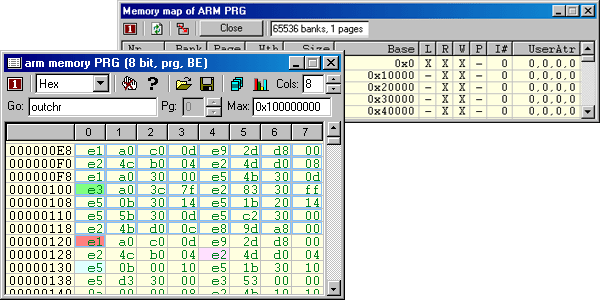|
|
 |
|
The memory
window displays the current contents of a memory. A CPU
model (ISS) may contain several different memories
(program, data, cache, ...), each with its own memory
window. Multiple memory windows can be opened to view
different areas of interest at once.
The maximum
size for a single memory is 4GB (32 bits address), even
if the workstation contains less physical memory, and
without loss of simulation speed.
C++ models of
peripherals may also contain one or more memory windows.
Dependent on the variable declaration in HDL designs, a
memory window is used to visualize and control the
contents of that variable (arrays).

|
|
|
|
|
 |
 View memory contents with user definable memory depth
and width
View memory contents with user definable memory depth
and width
 Change memory contents
Change memory contents
 Go box to jump to specific location or label
Go box to jump to specific location or label
 Coloring indicates recent
actions, breakpoint type and status, owner or sharing
features
Coloring indicates recent
actions, breakpoint type and status, owner or sharing
features
 Context sensitive popup information boxes
Context sensitive popup information boxes
 Unlimited amount of different types of breakpoints (no
influence on simulation speed)
Unlimited amount of different types of breakpoints (no
influence on simulation speed)
- on read, on write, on execution, on specific value, on
occurrence count
 Able to generate an interrupt when this location is
accessed (corner case testsing)
Able to generate an interrupt when this location is
accessed (corner case testsing)
 User selectable display mode
User selectable display mode
- Hexadecimal, decimal, float, formatted, ...
 Jump to source code (C or disassembly) line which is
responsible for current contents
Jump to source code (C or disassembly) line which is
responsible for current contents
 Memory map sub window
Memory map sub window
 Store data to file, Load data from file in more than 10
different predefined formats
Store data to file, Load data from file in more than 10
different predefined formats
 Copy contents from one memory to another memory
Copy contents from one memory to another memory |
|
|
|

